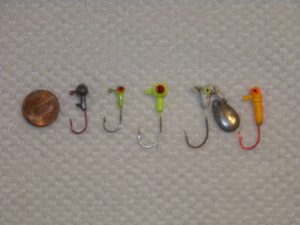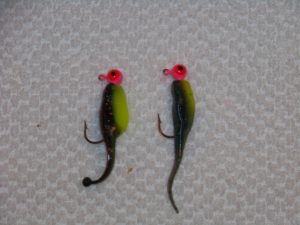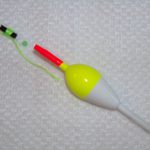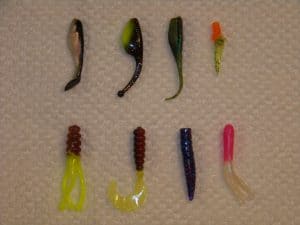Like any sport out there, Crappie fishing has its own set of gear and terms to learn and master.
In this article we will discuss Crappie fishing jigs – what they are and the different type of crappie fishing jigs available. For those that are fairly new to crappie fishing, I used the sentence “feel the thump” in the title because it is a common reference to jigging among crappie fishermen. You will see it like a motto on t-shirts and you will hear them state it out loud as well.
WHAT IS A CRAPPIE FISHING JIG?
A jig is a type of fishing lure made of a lead sinker with a hook that is usually covered by a soft body to attract fish.
Fishermen and women use the term “Jigging” when they are fishing with a jig.
Sport fishermen and women use jigs to create a jerky, vertical motion and most fish caught by jigs are suspended in the water column.
This is different than spinnerbaits. Spinnerbaits move through the water horizontally.
Because of its versatility the jig can be used in both salt and fresh water and many species of fish are attracted to the lure.
The attraction of the jig to fish makes it very popular with anglers.
As the name implies a crappie fishing jig is a type of jig that has proven to be very effective by anglers for catching crappie.
For successful jigging, the fisherman/woman needs to use a rod which is good for feeling a strike, and needs to stay in contact with the lure and get it to where the fish are.
What are the Different Kinds of Crappie Fishing Jigs?
You should use one of the four main types of jigs when jigging for crappie:
- Curly tail – This tail of this jig wiggles as it’s pulled through the water
- Plastic skirt – This jig is subtler than the above curly tail jig
- Marabou (hairy) – This crappie jig is said to “breathes” when moved slowly
- Fish-shaped – This crappie jig tends to closely mimic local forage
These four types of jigs combined with the right jig head, are often all you need to start catching crappie.
CRAPPIE JIG HEADS

Crappie jig heads are usually made out of lead or tungsten. This lends a good amount of weight.
1/32 to 1/8 oz jig heads are most commonly used when jigging for crappie. 1/16 and 1/32 are almost exclusively the sizes I use.
If you are ice fishing for crappie you will want to use lighter jigs due to crappie’s slower winter metabolism and inability to chase fast falling jigs.
You can try going larger than 1/8 oz late in winter and early spring when baitfish are larger.
Limit the length of a jig head to two inches or less. Anything bigger will not work for the majority of crappie.
Jig heads come in many shapes. By far the jig head most commonly used by crappie anglers is the ball style.
The ball style jig head provides uniform movement in all directions.
JIG AND JIG HEAD COLORS
There are quite a few differing opinions out there on which jig color to use. Some angles swear that chartreuse is always a good choice.
Of course, you should experiment and see what works.
Here are some general guidelines for choosing crappie jig head colors
- For clear water, use clear jigs.
- For dark water, use dark jigs and dark combinations of colors.
- For muddy water, use dark jigs.
HOW TO PLACE A CRAPPIE JIG ON A JIG HEAD
To place a crappie jig on a jig head, start by pushing the hook through the top of the jig.
Then, keep pushing the hook through the center of the jig body until the top of the jig meets the bottom of the jig 
Finally, poke the hook out of the crappie jig.
You want the jig head in line with the jig body and the hook centered through the jig body.
Here is a quick video:
TYING THE KNOT TO THE CRAPPIE JIG HEAD
You should know how to tie the clinch knot and the loop knot. These are two of the main knots to know for crappie fishing.
The clinch knot is easy to tie and is secure.
If you want to improve on the simple cinch knot use the Trilene (aka double clinch) knot.
Though this knot adds one more step in the tying process, the step improves the knot strength.
When using very small jigs (1/32 oz) or you want unrestricted movement of a barrel swivel, you can try the loop knot.
If you feel like you are getting lots of bites but cannot hook the crappie your problem maybe your knot placement.
Knot placement is important when jigging for crappie.
Place your knot on the jig head so that when the jig hang, it stays horizontal. If the jig hangs at an odd angle, crappie will be less attracted to the jig – This is extremely important!
You can try to open the hook slightly on the jig head to increase your hooking rate when jigging for crappie. This works because the hook points slightly up, allowing it to more easily to catch on the roof of a crappie’s mouth.
CRAPPIE FISHING JIG TECHNIQUES
Here are a couple of Crappie fishing jig techniques to try.
Jig and float:
The jig-n-float technique works great when crappie move shallow for their spawning run.
To use this technique, tie a jig a foot to four feet below the bobber. Adjust the depth that you fish depending on how deep the crappie are.
You will want the jig to be slightly above the crappie. Remember that crappie feed up.
Cast the jig out. To make it more attractive to the crappie, twitch the float and then hesitate. This will make the jig jump a little and swing back under the float.
Try fishing the jig-n-float over brush piles, stake beds and other shallow cover.
Good old fashioned Bobber technique:
Bobber fishing is a classic fishing method to catch any type of fish. With crappie fishing, it’s common to use a bobber with a minnow or a jig.
Bobbers allow for fishing at an exact depth and gives a visual cue when a fish strikes.
You can also cast further due to the added weight – helpful when trying to cast tiny jigs and lures (see bubble bobber below).
Essentially there are two types of bobbers – slip bobbers and stationary bobbers.
 Slip bobbers are used for fishing deep waters because they allow you to adjust line depth with a bobber stopper.
Slip bobbers are used for fishing deep waters because they allow you to adjust line depth with a bobber stopper.
Bobbers come in several shapes and sizes, including pencil and round styles. Pencil bobbers create less splash and noise when they impact the water. Pencil bobbers can be useful when trying to subtly present a lure to nearby crappie.
You can also get transparent “bubble” bobbers. You can fill a bubble bobber with water to add weight. The extra weight will help in windy situations when you want to cast a small jig but also want to be subtle.
Vertical Jigging:
Vertical jigging is the most common of all crappie fishing techniques. Vertical jigging is useful where casting is not an option, or there is heavy cover that requires finesse to properly present your jig.
When vertically jigging, you let the jig fall to the desired depth, then reel in slowly.
While reeling, move the tip of the rod up then pause lowering the rod to let the jig sink.
You keep repeating the reel and pause until your jig is retrieved.
The key is to keep your motion as fluid as possible. This gives the jig a lifelike swimming motion that will trick the crappie into thinking it’s actual prey.
CRAPPIE FISHING JIGS AND JIGGING – ESSENTIAL TOOLS FOR CRAPPIE ANGLING
Jigging is an important skill for any crappie fisherman/woman.
To start use 1/32 oz to 1/8 oz jig heads paired with a curly tail or marabou jig. Test with different colors and depths.
You will want to make sure to tie a good knot and place it on the jig head correctly to make the jig as effective as possible.
A vertical jigging rig is a common and effective way to start catching crappie. If you master crappie jigging techniques you will become a better crappie fisherman/woman.
I hope you enjoyed this post. Please leave me comments if you found this helpful!
Thank you,
Mike

